tow TOYOTA CAMRY 2019 Owners Manual (in English)
[x] Cancel search | Manufacturer: TOYOTA, Model Year: 2019, Model line: CAMRY, Model: TOYOTA CAMRY 2019Pages: 612, PDF Size: 11.44 MB
Page 3 of 612

3
1
8 7 5 4
3
2
CAMRY_U
9
6
3-1. Key informationKeys .................................. 134
3-2. Opening, closing and locking the doors
Doors................................. 143
Trunk ................................. 152
Smart key system.............. 157
3-3. Adjusting the seats Front seats ........................ 166
Rear seats ......................... 168
Head restraints .................. 170
3-4. Adjusting the steering wheel and mirrors
Steering wheel .................. 172
Inside rear view mirror....... 174
Outside rear view mirrors ............................. 176
3-5. Opening and closing the windows
Power windows ................. 178
Moon roof .......................... 182
Panoramic moon roof ........ 186 4-1. Before driving
Driving the vehicle ............. 192
Cargo and luggage ............ 200
Vehicle load limits .............. 203
Trailer towing ..................... 204
Dinghy towing .................... 205
4-2. Driving procedures Engine (ignition) switch (vehicles without a
smart key system) ........... 206
Engine (ignition) switch (vehicles with a
smart key system) ........... 208
Automatic transmission ..... 213
Turn signal lever ................ 219
Parking brake .................... 220
Electric parking brake ........ 221
Brake Hold ......................... 225
4-3. Operating the lights and wipers
Headlight switch ................ 227
Automatic High Beam ........ 231
Windshield wipers and washer ...................... 235
4-4. Refueling Opening the fuel tank cap ........................... 239
3Operation of each
component4Driving
Page 6 of 612

TABLE OF CONTENTS6
CAMRY_U7-1. Essential information
Emergency flashers .......... 486
If your vehicle has to be stopped in
an emergency ................. 487
7-2. Steps to take in an emergency
If your vehicle needs to be towed ..................... 489
If you think something is wrong........................... 495
Fuel pump shut off system............................. 496
If a warning light turns on or a warning
buzzer sounds................. 497
If a warning message is displayed ..................... 507
If you have a flat tire .......... 512
If the engine will not start ..................... 524
If the electronic key does not operate properly ........ 526
If the vehicle battery is discharged ................... 529
If your vehicle overheats ........................ 534
If the vehicle becomes stuck ................ 537 8-1. Specifications
Maintenance data (fuel, oil level, etc.) .......... 540
Fuel information ................. 551
Tire information.................. 554
8-2. Customization Customizable features ....... 567
8-3. Items to initialize Items to initialize ................ 575
Reporting safety defects for U.S. owners ........................ 578
Seat belt instructions for Canadian owners
(in French)................................ 579
SRS airbag instructions for Canadian owners
(in French)................................ 581
7When trouble arises8Vehicle specifications
9For owners
Page 16 of 612
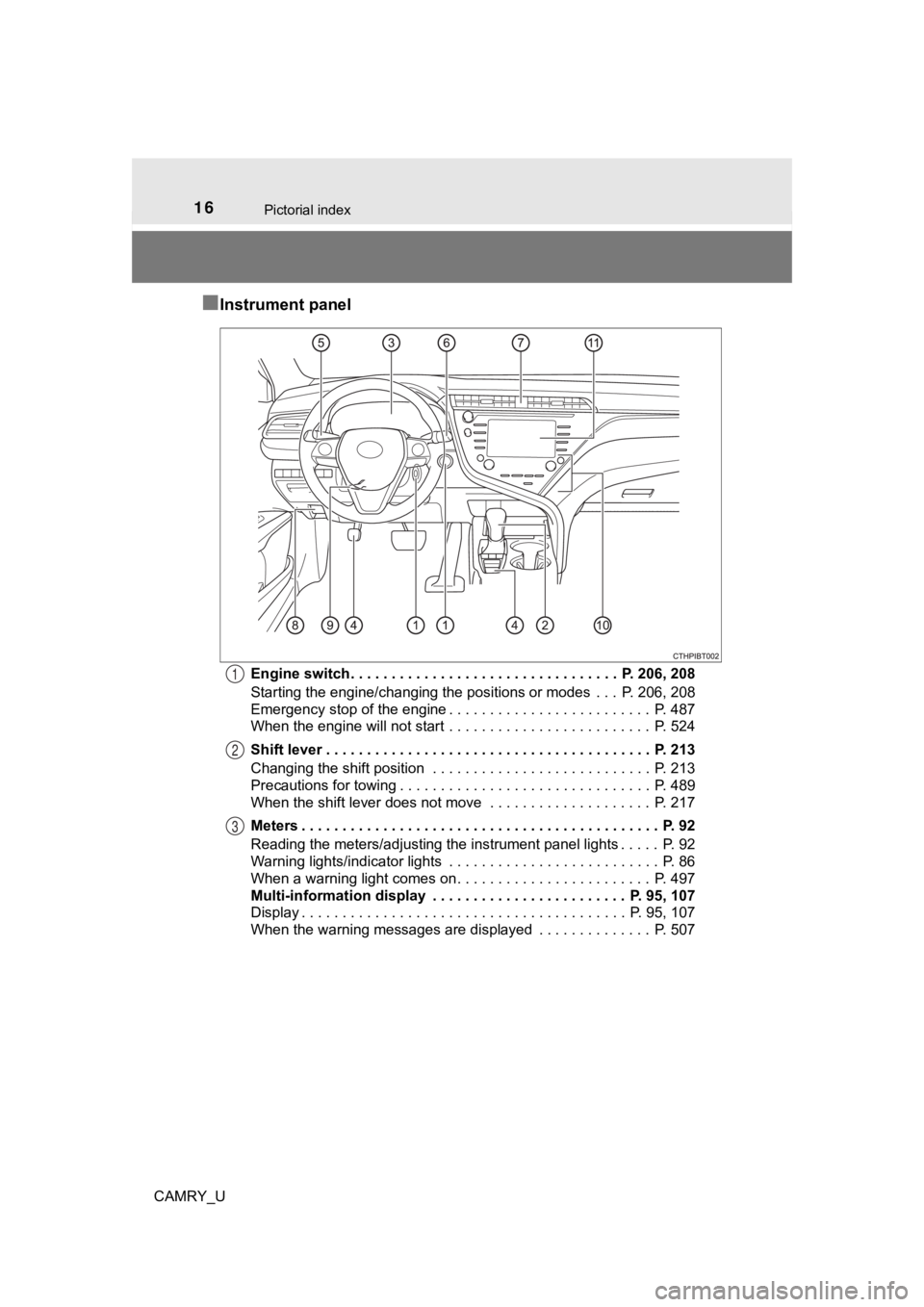
16Pictorial index
CAMRY_U
■Instrument panel
Engine switch . . . . . . . . . . . . . . . . . . . . . . . . . . . . . . . . . P. 206, 208
Starting the engine/changing the positions or modes . . . P. 206, 208
Emergency stop of the engine . . . . . . . . . . . . . . . . . . . . . . . . . P. 487
When the engine will not start . . . . . . . . . . . . . . . . . . . . . . . . . P. 524
Shift lever . . . . . . . . . . . . . . . . . . . . . . . . . . . . . . . . . . . . . . . . P. 213
Changing the shift position . . . . . . . . . . . . . . . . . . . . . . . . . . . P. 213
Precautions for towing . . . . . . . . . . . . . . . . . . . . . . . . . . . . . . . P. 489
When the shift lever does not move . . . . . . . . . . . . . . . . . . . . P. 217
Meters . . . . . . . . . . . . . . . . . . . . . . . . . . . . . . . . . . . . . . . . . . . . P. 92
Reading the meters/adjusting the instrument panel lights . . . . . P. 92
Warning lights/indicator lights . . . . . . . . . . . . . . . . . . . . . . . . . . P. 86
When a warning light comes on . . . . . . . . . . . . . . . . . . . . . . . . P. 497
Multi-information display . . . . . . . . . . . . . . . . . . . . . . . . P. 95, 107
Display . . . . . . . . . . . . . . . . . . . . . . . . . . . . . . . . . . . . . . . . P. 95, 107
When the warning messages are displayed . . . . . . . . . . . . . . P. 5071
2
3
Page 37 of 612

371-1. For safe use
1
For safety and security
CAMRY_U
WARNING
■SRS airbag precautions
Observe the following precautions regarding the SRS airbags.
Failure to do so may cause death or serious injury.
● The driver and all passengers in the vehicle must wear their se at belts
properly.
The SRS airbags are supplemental devices to be used with the se at belts.
● The SRS driver airbag deploys with considerable force, and can cause
death or serious injury especially if the driver is very close to the airbag.
The National Highway Traffic Safety Administration (NHTSA) advi ses:
Since the risk zone for the driver’s airbag is the first 2 - 3 in. (50 - 75 mm)
of inflation, placing yourself 10 in. (250 mm) from your driver airbag pro-
vides you with a clear margin of safety. This distance is measured from
the center of the steering wheel to your breastbone. If you sit less than 10
in. (250 mm) away now, you can change your driving position in several
ways:
• Move your seat to the rear as far as you can while still reach ing the ped-
als comfortably.
• Slightly recline the back of the seat. Although vehicle designs vary, many drivers can achieve the 10 in. (250
mm) distance, even with the driver seat all the way forward, si mply by
reclining the back of the seat somewhat. If reclining the back of your
seat makes it hard to see the road, raise yourself by using a f irm, non-
slippery cushion, or raise the seat if your vehicle has that feature.
• If your steering wheel is adjustable, tilt it downward. This points the air- bag toward your chest instead of your head and neck.
The seat should be adjusted as recommended by NHTSA above, whil e
still maintaining control of the foot pedals, steering wheel, and your view
of the instrument panel controls.
Page 39 of 612
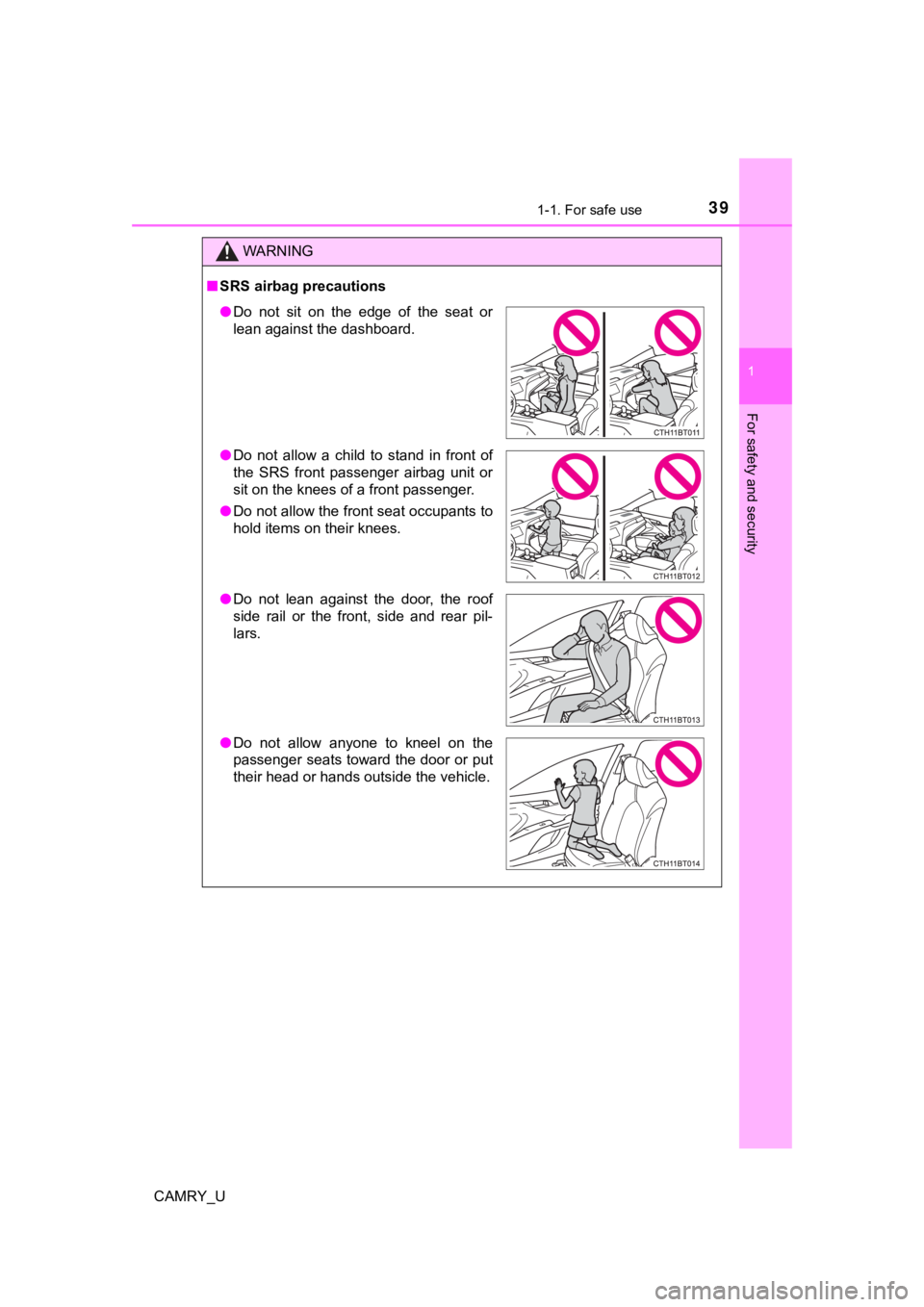
391-1. For safe use
1
For safety and security
CAMRY_U
WARNING
■SRS airbag precautions
● Do not sit on the edge of the seat or
lean against the dashboard.
● Do not allow a child to stand in front of
the SRS front passenger airbag unit or
sit on the knees of a front passenger.
● Do not allow the front seat occupants to
hold items on their knees.
● Do not lean against the door, the roof
side rail or the front, side and rear pil-
lars.
● Do not allow anyone to kneel on the
passenger seats toward the door or put
their head or hands outside the vehicle.
Page 65 of 612
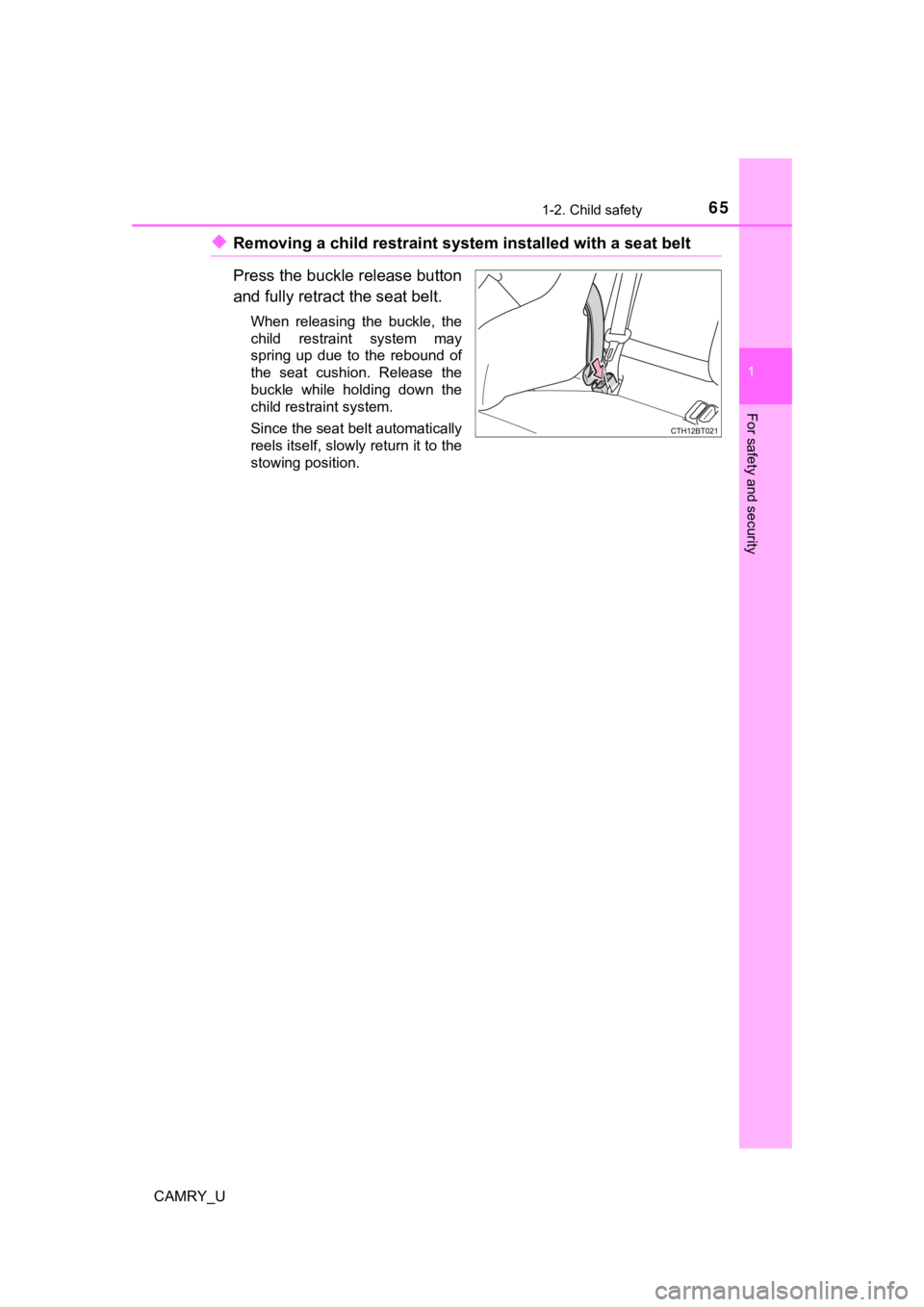
651-2. Child safety
1
For safety and security
CAMRY_U
◆Removing a child restraint system installed with a seat belt
Press the buckle release button
and fully retract the seat belt.
When releasing the buckle, the
child restraint system may
spring up due to the rebound of
the seat cushion. Release the
buckle while holding down the
child restraint system.
Since the seat belt automatically
reels itself, slowly return it to the
stowing position.
Page 77 of 612
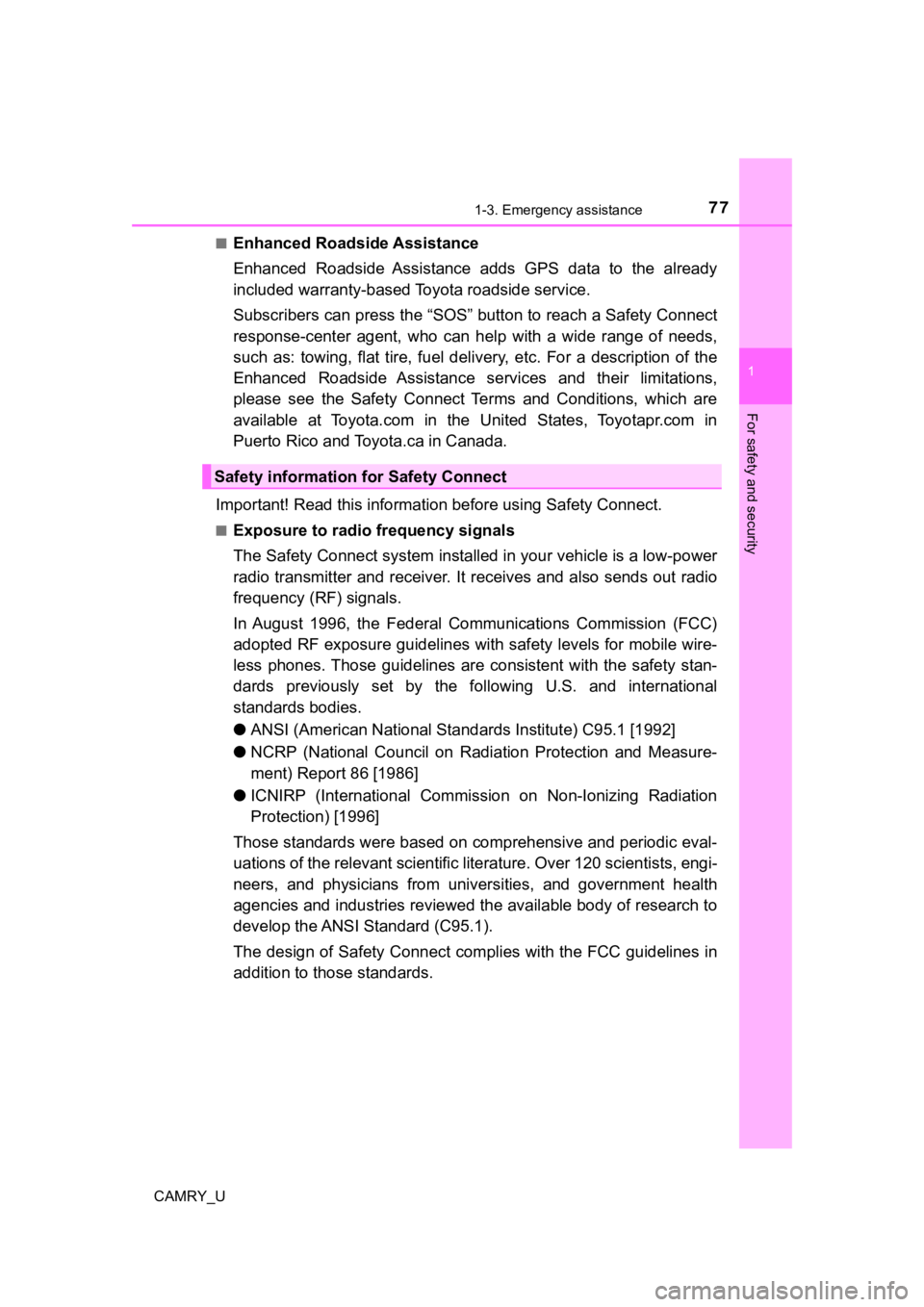
771-3. Emergency assistance
1
For safety and security
CAMRY_U■
Enhanced Roadside Assistance
Enhanced Roadside As
sistance adds GPS data to the already
included warranty-based Toyota roadside service.
Subscribers can press the “SOS” button to reach a Safety Connec t
response-center agent, who can he lp with a wide range of needs,
such as: towing, flat tire, fuel delivery, etc. For a description of the
Enhanced Roadside Assistance se rvices and their limitations,
please see the Safety Connect Te rms and Conditions, which are
available at Toyota.com in the United States, Toyotapr.com in
Puerto Rico and Toyota.ca in Canada.
Important! Read this informatio n before using Safety Connect.
■Exposure to radio frequency signals
The Safety Connect system installed in your vehicle is a low-po wer
radio transmitter and receiver. I t receives and also sends out radio
frequency (RF) signals.
In August 1996, the Federal Communications Commission (FCC)
adopted RF exposure guidelines with safety levels for mobile wi re-
less phones. Those guidelines are consistent with the safety stan-
dards previously set by the following U.S. and international
standards bodies.
● ANSI (American National Stand ards Institute) C95.1 [1992]
● NCRP (National Council on Radi ation Protection and Measure-
ment) Report 86 [1986]
● ICNIRP (International Commission on Non-Ionizing Radiation
Protection) [1996]
Those standards were based on comprehensive and periodic eval-
uations of the relevant scienti fic literature. Over 120 scientists, engi-
neers, and physicians from unive rsities, and government health
agencies and industries reviewed the available body of research to
develop the ANSI Standard (C95.1).
The design of Safety Connect complies with the FCC guidelines i n
addition to those standards.
Safety information for Safety Connect
Page 136 of 612
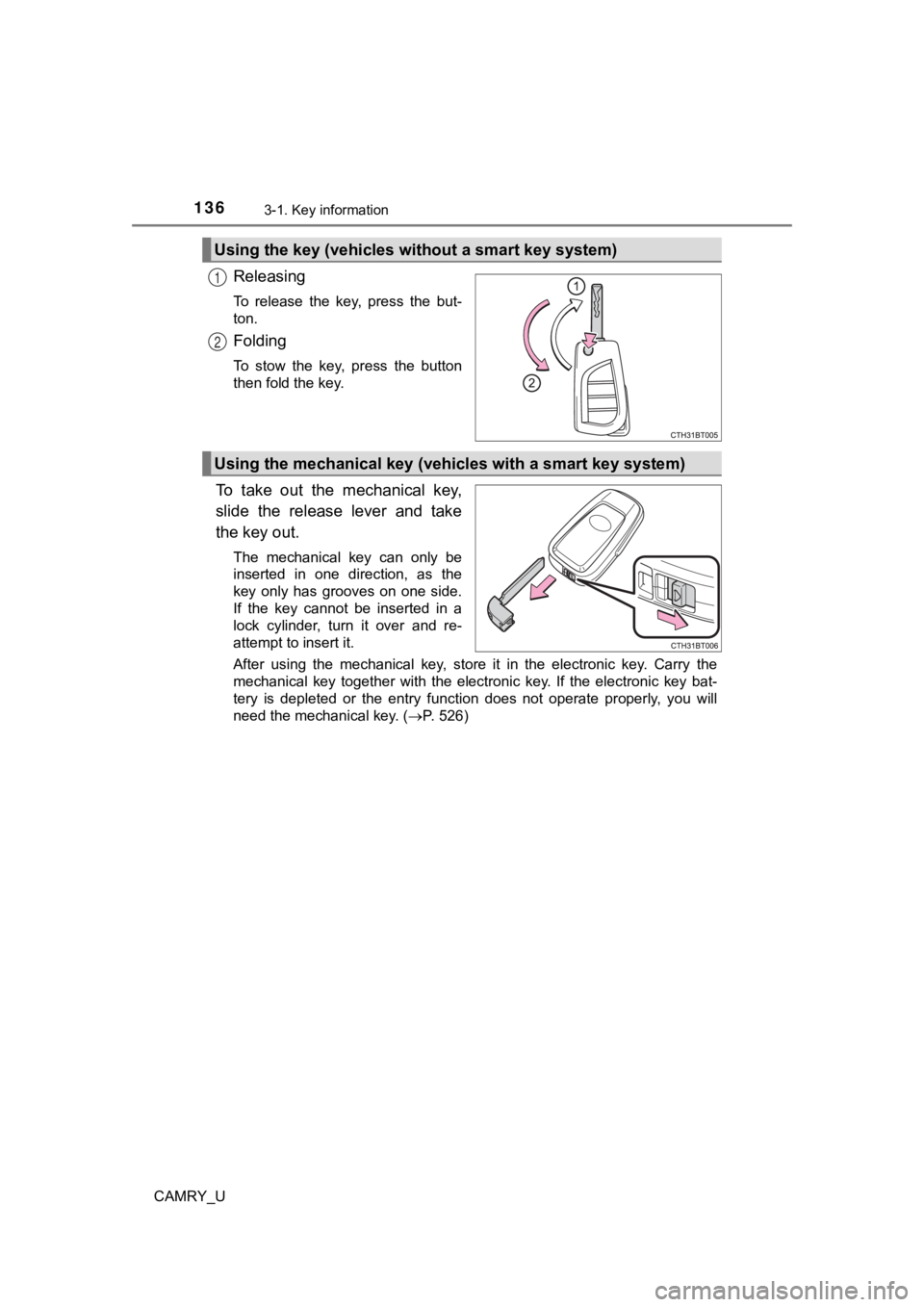
1363-1. Key information
CAMRY_U
Releasing
To release the key, press the but-
ton.
Folding
To stow the key, press the button
then fold the key.
To take out the mechanical key,
slide the release lever and take
the key out.
The mechanical key can only be
inserted in one direction, as the
key only has grooves on one side.
If the key cannot be inserted in a
lock cylinder, turn it over and re-
attempt to insert it.
After using the mechanical key, store it in the electronic key. Carry the
mechanical key together with the electronic key. If the electro nic key bat-
tery is depleted or the entry function does not operate properl y, you will
need the mechanical key. ( P. 526)
Using the key (vehicles without a smart key system)
1
2
Using the mechanical key (vehic les with a smart key system)
Page 138 of 612

1383-1. Key information
CAMRY_U■
If you lose your keys
New genuine keys can be made by your Toyota dealer using the ot her key
(vehicles without a smart key system) or the other mechanical k ey (vehicles
with a smart key system) and the key number stamped on your key number
plate. Keep the plate in a safe place such as your wallet, not in the vehicle.
■ When riding in an aircraft
When bringing a key with wireless remote control function onto an aircraft,
make sure you do not press any button on the key while inside t he aircraft
cabin. If you are carrying the key in your bag etc., ensure tha t the buttons are
not likely to be pressed accidentally. Pressing a button may cause the key to
emit radio waves that could interfere with the operation of the aircraft.
■ Conditions affecting operation
Vehicles without a smart key system
The wireless remote control function may not operate normally i n the follow-
ing situations:
● When the wireless key battery is depleted
● Near a TV tower, electric power plant, gas station, radio stati on, large dis-
play, airport or other facility that generates strong radio wav es or electrical
noise
● When carrying a portable radio, cellular phone or other wireles s communi-
cation devices
● When the wireless key is in contact with, or is covered by a me tallic object
● When other wireless key (that emit radio waves) is being used n earby
● If window tint with a metallic content or metallic objects are attached to the
rear window
Vehicles with a smart key system
P. 159
Page 159 of 612
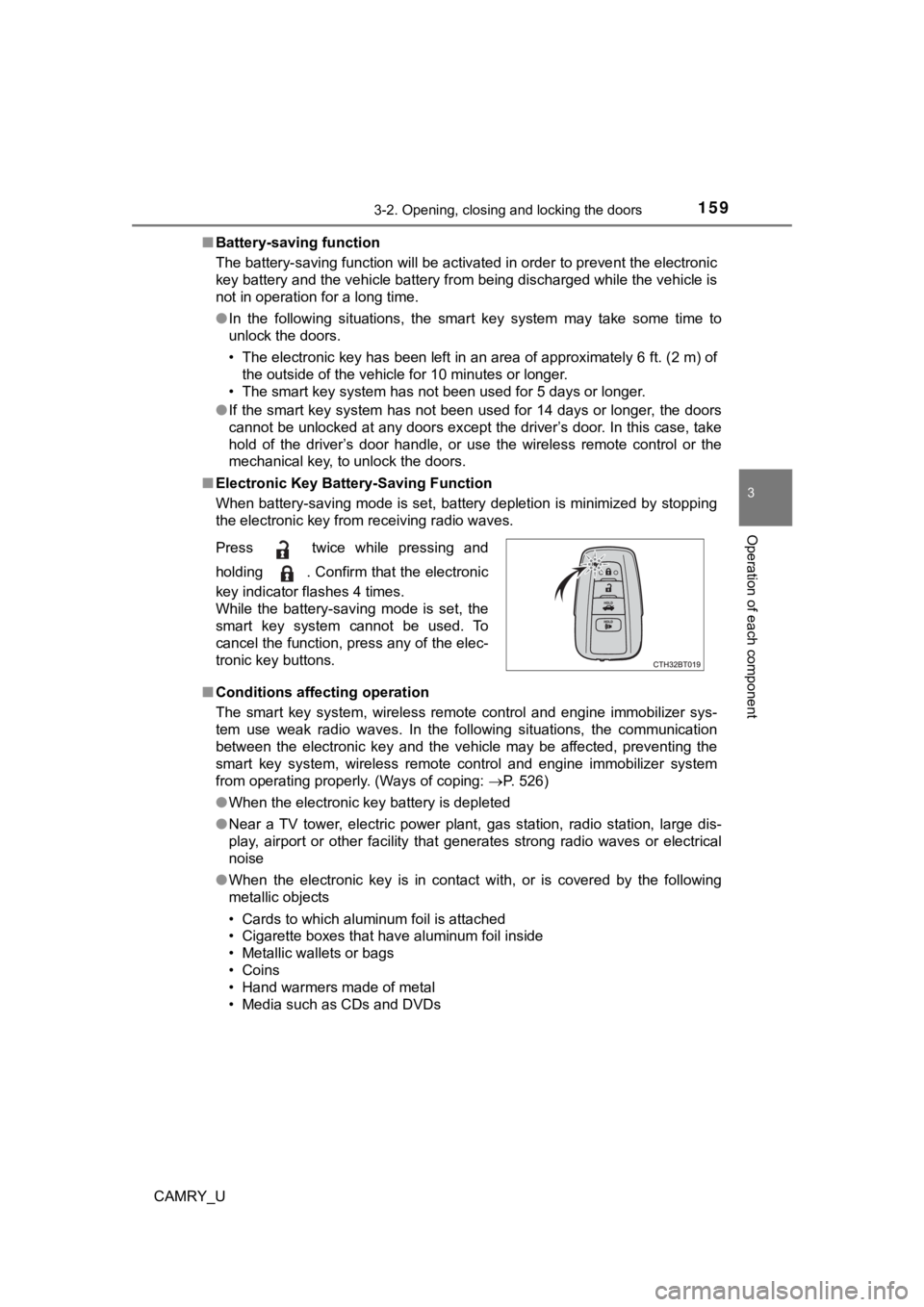
1593-2. Opening, closing and locking the doors
3
Operation of each component
CAMRY_U■
Battery-saving function
The battery-saving function will be activated in order to preve nt the electronic
key battery and the vehicle battery from being discharged while the vehicle is
not in operation for a long time.
● In the following situations, the smart key system may take some time to
unlock the doors.
• The electronic key has been left in an area of approximately 6 ft. (2 m) of
the outside of the vehicle for 10 minutes or longer.
• The smart key system has not been used for 5 days or longer.
● If the smart key system has not been used for 14 days or longer , the doors
cannot be unlocked at any doors except the driver’s door. In th is case, take
hold of the driver’s door handle, or use the wireless remote co ntrol or the
mechanical key, to unlock the doors.
■ Electronic Key Battery-Saving Function
When battery-saving mode is set, battery depletion is minimized by stopping
the electronic key from receiving radio waves.
■ Conditions affecting operation
The smart key system, wireless remote control and engine immobi lizer sys-
tem use weak radio waves. In the following situations, the communication
between the electronic key and the vehicle may be affected, pre venting the
smart key system, wireless remote control and engine immobilizer system
from operating properly. (Ways of coping: P. 526)
● When the electronic key battery is depleted
● Near a TV tower, electric power plant, gas station, radio stati on, large dis-
play, airport or other facility that generates strong radio wav es or electrical
noise
● When the electronic key is in contact with, or is covered by the following
metallic objects
• Cards to which aluminum foil is attached
• Cigarette boxes that have aluminum foil inside
• Metallic wallets or bags
• Coins
• Hand warmers made of metal
• Media such as CDs and DVDs
Press twice while pressing and
holding . Confirm that the electronic
key indicator flashes 4 times.
While the battery-saving mode is set, the
smart key system cannot be used. To
cancel the function, press any of the elec-
tronic key buttons.